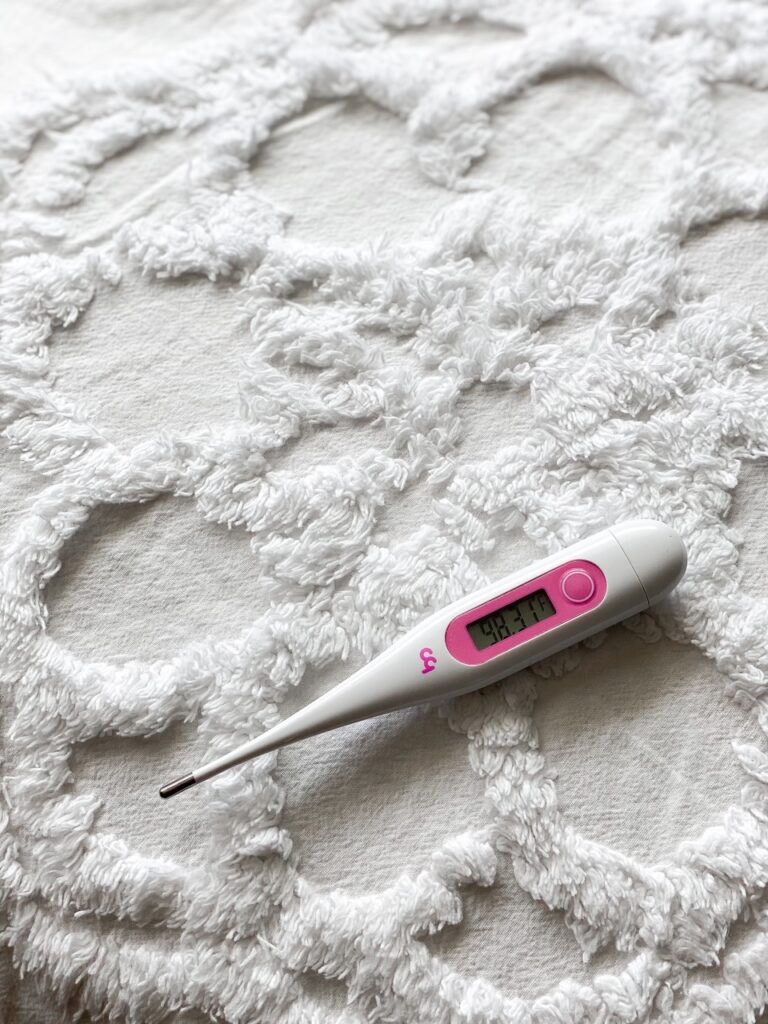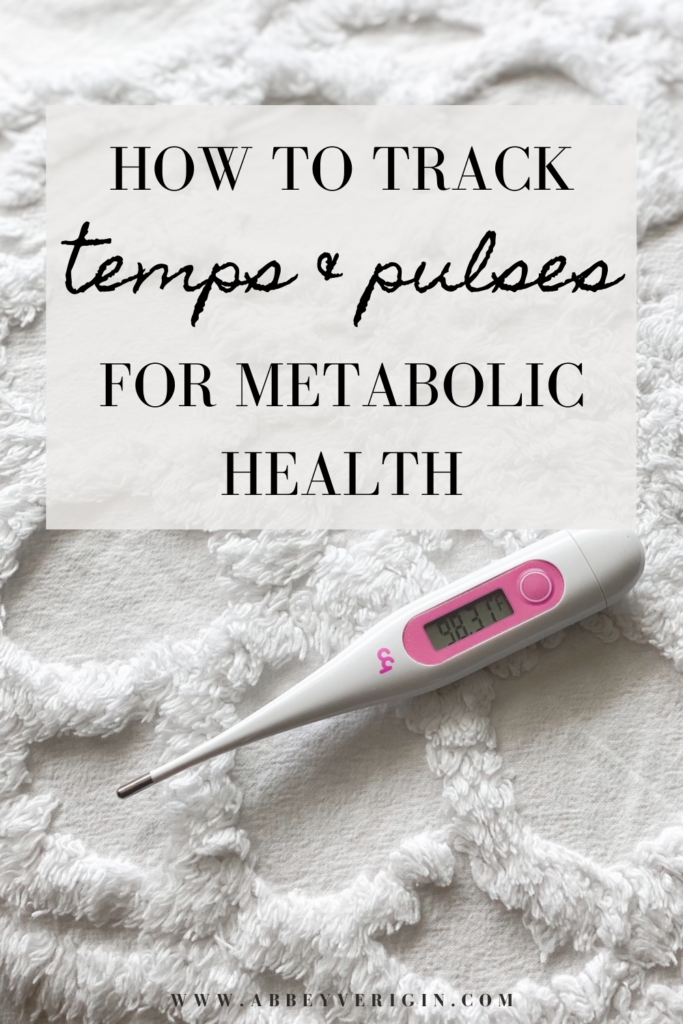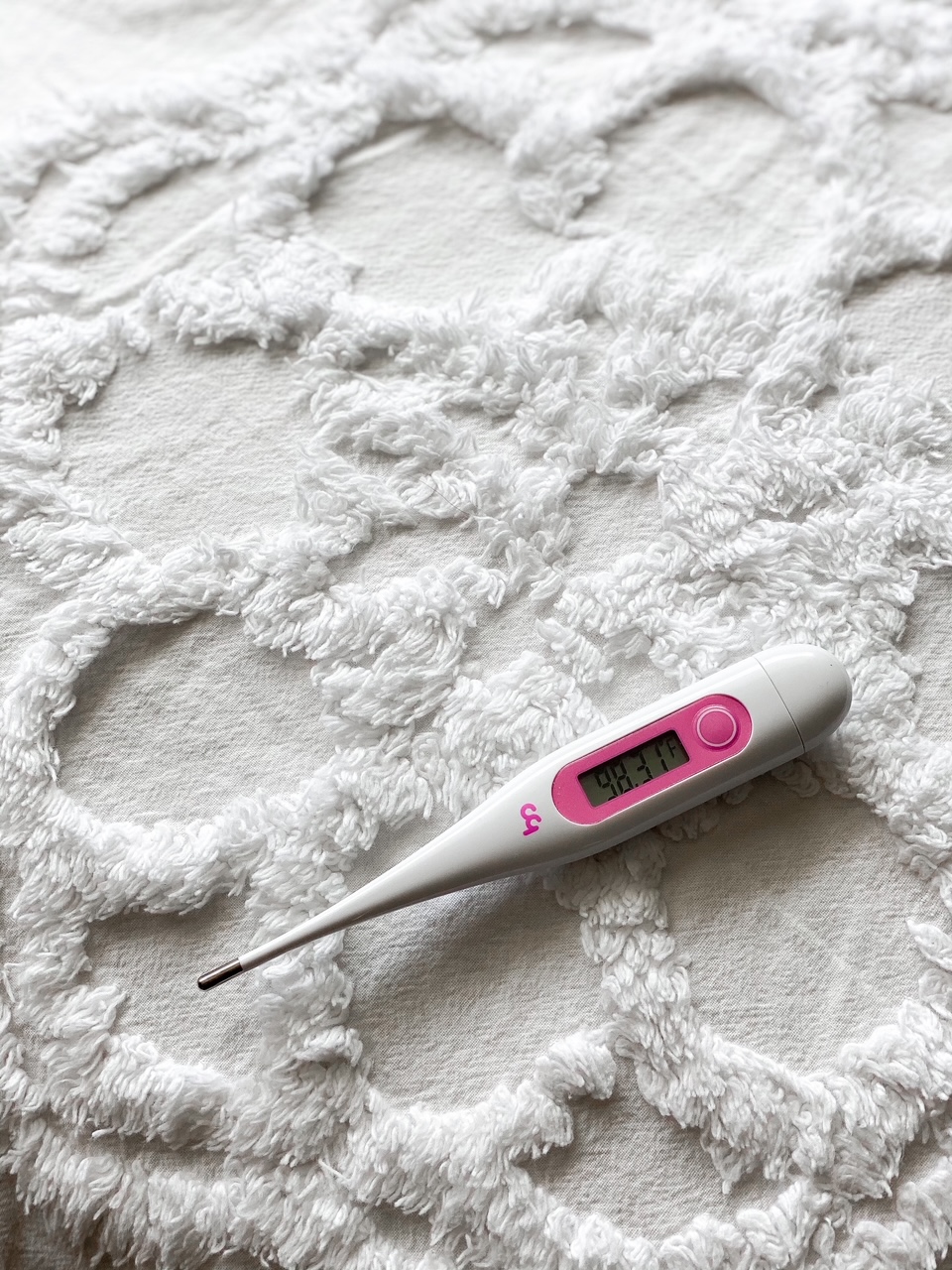Tracking temps and pulses is a great way to check in on your metabolic health. Body temperature and heart rate are two vital signs.

Before I dive into how to track temps & pulses, of course you’re going to want to understand why you would want to! Before we get there I’d like to start out by sharing my experience with tracking my temps & pulses and how that information has helped me improve my metabolic function and overall health.
Tracking temperatures and pulses is a great way to check in to see how our metabolism is doing as a whole, but also to see whether our diet and lifestyle is hindering or supporting our metabolic health.
Why I Started Tracking Temps & Pulses
This past year I realized that something wasn’t working. It always feels a little vulnerable to talk about dealing with your own health issues when you’re in the health and wellness sphere. My nutrition was near perfect, I was supplementing appropriately, yet I was experiencing a slew of symptoms, some imbalances, and deficiencies. I had to sit back and really take a look at everything that I believe about health and nutrition, and see where I was falling into nutrition dogma, despite my best efforts. I focused on what we know about human physiology, started tracking my food for awhile to get a feel for where my caloric intake was at.
Turns out, I was doing the one thing I warn clients not to. I was majorly undereating, unintentionally. I also recognized that my carbohydrate was far too low, and not supportive of hormone function. There’s a whole lot of talk these days about low carb, sugar free diets, however the fact is our bodies run off of glucose. That’s not just a belief I have, it is a known fact.
Luckily, I had the balanced, blood sugar regulating meals down perfectly. It has been a focus of mine in my practice, so I knew the importance. I just had to get real with myself and realize I was not fueling my body as it needed in order to thrive.
So, I began taking my temps and pulses every day, multiple times a day, for the last 4+ months to get a better feel for where my body is at. I am no stranger to temping, and had done so in the past, but once I got familiar with my cycles I let that go.
I was shocked to see that my waking temps were in the 95’s. That is insanely low, and made it very clear to me that despite everything I know about nutrition, my metabolism was not functioning optimally. My body needed more fuel. Now, normally my recommendation if I was working with a client would be to slowly increase calories week by week, to avoid weight gain. If you’re familiar with The Four Tendencies, I am a rebel to my core. I went all in, drastically increased my carbohydrates, and upped my calories by over 1000. That might sound like backwards nutrition advice, but our bodies need fuel and my symptoms, temps, and pulses were begging me for more.
Yes, I have seen a little weight gain, but I have also seen the most stable moods I have ever had. Clear, bright skin, easy periods, great digestion, no more hair loss, and so much more. My temperatures are up in a normal range, and I have honestly never felt better.
Maybe you’re eating enough, maybe you aren’t, but either way I feel that you will learn so much about yourself if you implement taking your temps and pulses on a daily basis!
What Is Our Metabolism
When you hear metabolism, you are likely thinking the rate in which we burn fat. While that isn’t untrue, there is so, so much more to it. Our metabolism refers to every single metabolic process in our body. Think your immune system, sex hormones, and everything beyond. Our metabolism refers to how our body takes things like glucose, vitamins, minerals, proteins, and fats and turns them into energy, or heat.
Our metabolism directly impacts our hormones. Hormones are simply chemical messengers that cells send to one another as a form of communication. If cells are stressed out, not function as they should, or haven’t been given the tools they need to function properly (ie, food!), our hormones are going to begin to get a little out of whack.
What To Keep In Mind With Temps & Pulses
While utilizing temperatures and pulses, keep in mind that they are a great tool, but numbers aren’t the end all, be all. Later I will share some markers of good metabolic health. If you are checking off everything (or most) on that list, but your temperatures and pulses aren’t in the recommended range, there is a chance that your normal is a little different than what is said to be normal. On the flip side, if temperatures and pulses are improving, but symptoms and quality of life aren’t, they don’t mean much. Keep in mind, these are a tool, nothing to obsess over. Check in with your body.
Markers For A Strong Metabolism
Spoiler alert: your metabolic function is not determined by the size clothes you wear or your weight. If you are happy with the size clothing you wear, and you like the number on the scale, that’s great, but frankly it doesn’t mean much if you don’t have the markers of health.
- Warm Hands & Feet
- Steady Energy Throughout The Day
- Strong Libido
- Easily Falls Asleep & Stays Asleep
- Strong Hair & Nails
- Great Digestion
- 1-3 Good Bowel Movements Every Day
- Regular Periods/Ovulation Free From PMS Symptoms
- Happy & Positive Disposition
- Maintains Weight Easily
- Strong Immune System
- Waking Up With An Appetite!
- Basal Body Temperature Between 97.8-98.6 F or 36.6-37.0 C
- Pulses Between 75-90 BPM
For women, a low sex drive is normalized way too much. A strong libido signifies our body craving reproduction. If our body isn’t craving reproduction, it likely isn’t in a good place for it and doesn’t have what it needs to do so. I know fertility is a touchy subject, but it is the ultimate marker of health.
If you find that it is hard to maintain a healthy weight, your metabolism needs support. We should have metabolic flexibility. If a weekend away eating foods you wouldn’t normally eat causes you to gain 5 pounds, that is definitely a sign of metabolic dysfunction. You should be able to have flexibility with your diet and exercise routine without seeing your weight fluctuate much. Our bodies should be resilient.
What about mood? Are you constantly experiencing mood swings throughout the day and cycle, and hangry all the time? Anxious feelings all the time? These symptoms are all so common, and they point towards hormonal imbalance. You may notice a pattern here, but common and normal are not the same thing. When your metabolic function is optimal, your hormones are functioning properly, a happy mood will be your norm. That doesn’t mean you won’t have hard days or even moments, it just means that they will be that much easier to handle.
Why Are Temperatures A Good Marker For Health
Why are temperatures a good marker of our overall health? Generating heat is a sign that our cells are utilizing the energy that they have been given. Typically, a high heat indicates a high functioning metabolism. The warmer our bodies are, the more calories burned at rest. All that being said, sometimes when our bodies are experiencing hormonal imbalance, they will use stress hormones like cortisol to make energy, which can also generate heat. I’m sure you have gone through a stressful time before where you’ve felt hot and sweaty, and this is exactly why. We want our bodies burning energy because our metabolism is functioning well, not because it is running on stress hormones. This is why using temperatures and pulses are great tools to use in conjunction with each other.
Why Are Pulses A Good Marker For Health
Our bodies get nutrients and oxygen to the cells by pumping blood. When our bodies are in a stressed state and running on adrenaline, they need those nutrients and oxygen a lot quicker, which is what raises our pulse. At some point as we deplete these nutrients, our body realizes it needs to start conserving energy. When our bodies are in this state of conservation and trying to work more efficiently, our pulse is going to slow right down. Our aim is to have them somewhere right in the middle, when our bodies are not stressed or conserving energy.
As you can see, measuring both temperatures and pulses give us a better picture of what is going on.
How To Track Temperatures For Metabolic Health
I’m sure you know how to take your temperature, but there are some things you need to know! To take your temperature you are going to need a basal body thermometer. You will take your temperature by placing the thermometer either under your tongue, or in your armpit.
You will want to take several readings of your temps and pulses throughout the day if you’d like to get a real good picture of where you’re at. At minimum, you will want to take your temps and pulses at waking. Ideally, at waking, an hour after breakfast, and mid afternoon would be a great starting place. This will give you a clear picture of whether or not your temperature is slowly rising throughout the day, which is the goal!
To take your temperature in the morning, you will want to take it before getting out of bed. As soon as you roll over, while laying down, take your temp to ensure an accurate reading. If your sleep is disturbed by waking, your temps could be effected, especially if it was disturbed less than 4-5 hours before waking.
Other ways that you can utilize taking your temperatures include taking them 40-60 minutes post workout or post meals. This will give you a good feeling for how your body is responding to a workout or certain foods. If you find post workout that your temps drop significantly, it is likely that your body cannot handle that level of stress yet.
At waking, your temperature will likely be the lowest of the day, with your temperature peaking mid afternoon, then slowly decreasing before bedtime. Ideally your waking temperature would start out around 97.8, slowly increasing to 98.6 throughout the course of the day. If your temperature starts out low or is dipping throughout the day, this shows us the metabolism is not functioning optimally and likely requires more support through nutrition and lifestyle.
How To Track Pulses For Metabolic Health
You will want to take your pulses whenever you take your temperature. For me, keeping track of my temps and pulses in the calendar app on my phone has been super useful and insightful when I go back through them after some time.
To take your pulse, you can either use your fingers, or purchase and oximeter. Fingers are the cheapest and easiest way to take your pulse. Find your pulse on your wrist, then start a stop watch on your phone for 15 seconds and count the beats. Multiply that number by 4, and you have your BPM.
Like temperatures, pulses will slowly increase over the course of the day. At waking, ideally pulse would sit around 70 BPM, with it raising to close to 90 BPM by mid afternoon. I’m sure this range is higher than what you’ve heard of as healthy. Low pulse rates are typically associated with athletes, however a low pulse is a sure sign our metabolism is not functioning optimally.
Again, if you are seeing fluctuations and dips throughout the day we need to look a little closer. Was a workout too much for your body to handle, or a certain food not agreeing with you? If this is happening, your metabolism likely needs more support through nutrition and lifestyle. Eventually when the metabolism is functioning optimally, it won’t be so effected by these things.
What Do My Temps & Pulses Mean?
So you have started tracking your temperatures and pulses. What do they mean? If our temperatures are low, our hormones and metabolism are not functioning optimally.
Low Temperature with Low Pulse: Poorly functioning metabolism. This is very common as most of us has been in some form of state of stress, long term.
Low Temperature with Strong Pulse: We are under active stress and our metabolism is suppressed because of it.
Normal Temperature with Low Pulse: Metabolism is not functioning optimally, and heat is likely coming from running on stress.
Normal Temperature with High Pulse: We are in an active state of stress, and our metabolism will be suppressed. Our body is likely still responding to an acute stressor.
Our goal is to have both our temperatures and our pulses in that optimal range.
How Can I Optimize My Temps & Pulses
If your temperatures and pulses are low, take a look at your nutrition and lifestyle. Are they supporting your body, or contributing to stress? If you are finding they decrease throughout the day or jump around, let’s ask why that is happening. How are we feeling, exercising, eating?
If your temps and pulses are dropping after a meal, we need to consider whether it is because we were running on stress hormones prior to the meal, and refueling brought those stress hormones down, or whether our body simply does not agree with what we ate. Ask yourself when your last meal was, and if it was calorically dense enough with a good balance of carbohydrates, protein, and fat. If it has been hours since your last meal, there is a good chance you were running on stress hormones. Check in with the strong metabolism markers above.
What Can Effect Change In Temps & Pulses
As we will discuss below, where you are at in your cycle will definitely impact your temperatures. If you find your temperatures are pretty steady, yet one morning you have a significantly high or low temp that cannot be correlated with where you are at in your cycle, there are a number of factors that could be impacting it. Alcohol consumption, disturbed sleep, using heating pads, eating something that doesn’t agree with your body, could all impact your temperatures and pulses. Take note and you may be able to find a trigger when reviewing in the future. For me, I know that consuming alcohol will impact my waking temperature the next day.
Temps & Pulses And The Menstrual Cycle
As you begin temping, you will notice that your temperatures tend to shift depending where you are at in your cycle. While on your period you can expect your temperatures to be low as our hormones are at their lowest at this point. You will likely see a drop in temperature right before ovulation. About 24 hours after ovulation, your temps will rise somewhere between 0.5-1.0 F once we start making progesterone. A rise in temperature that stays up is how we confirm that ovulation occured.
Our temperatures will vary at different points in the cycle, so tracking them can help give us a better picture of where we are at, as well as confirming ovulation.
A period is not actually a period if there is no ovulation. Without ovulation, progesterone is not produced. If you can tell based on your temperatures that there was no ovulation, yet you bleed, what you are experiencing is likely breakthrough bleeding. I will put together a separate post going into detail on this! Ovulation is the entire point of a woman’s cycle, and if you are regularly having anovulatory cycles, this needs to be addressed regardless of whether planning a pregnancy is on your radar.
Basal Body Temperature For Natural Family Planning
Another great way to utilize Basal Body Temperature (BBT) is as a natural form of birth control. When you are taking your BBT on a daily basis, it can provide insight into your cycle. You can use this data to either prevent or plan pregnancy.
You may hear this form of natural family planning called the basal body temperature method or the fertility awareness method. First, understand that your basal body temperature is your temperature at rets. Ovulation will cause an increase of 0.5-1.0 F increase in temperature.
You are most fertile the two to three days before you see that rise in temperature. By tracking your basal body temperature daily, you can predict when you will ovulate. I highly recommend temping on a daily basis for several months before implementing natural family planning. This method can be almost fool proof, about 99% effective, if practiced properly.
You need to take your temperature about the same time every morning prior to getting out of bed. These temperatures should be charted on a daily basis to give a clear picture of any drops or spikes. For some women this could be a pen to paper, however there are also many apps available. You can even get Basal Body Thermometers that connect to the app through bluetooth to save you the step.
If using BBT as a form of birth control, I highly recommend using it in combination with other fertility awareness methods. This is because you still have several fertile days before you see a change in temperatures. Monitoring your temps over several months to make sure your cycles are regular will help. Other fertility awareness methods include becoming familiar with cervical mucus.
I also recommend recording changes in cervical mucus daily to become familiar with your cycle. Prior to ovulation, you will likely experience cervical mucus that is egg white like in consistency. This is the most fertile cervical mucus, so you can utilize that knowledge whether you are trying to prevent or plan pregnancy. Around ovulation this may change to watery cervical mucus, which is also very fertile.
Sperm can survive up to 5 days, so take this into consideration with your ovulation date. It is best to implement other forms of birth control for up to a week before predicted ovulation. Just because fertile cervical mucus is not present, does not mean you are not fertile.
My Favorite Products For Metabolic Support And Tracking Temps & Pulses
How To Heal Your Metabolism by Kate Deering
Pin It For Later



This article has been so helpful for me thank you. A year into healing my metabolism my temps are healthy, I’ve gained weight, my anxiety is gone! Still working on this. Not everything is healthy yet but miles from where I was! Thanks for the article.
So glad you found it helpful!